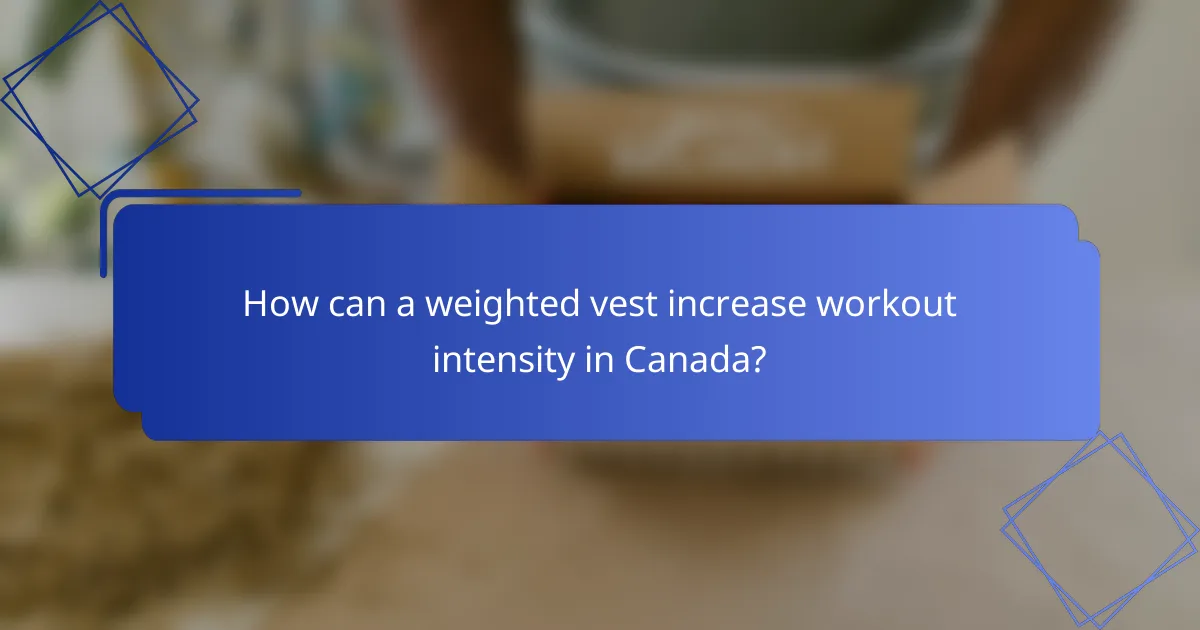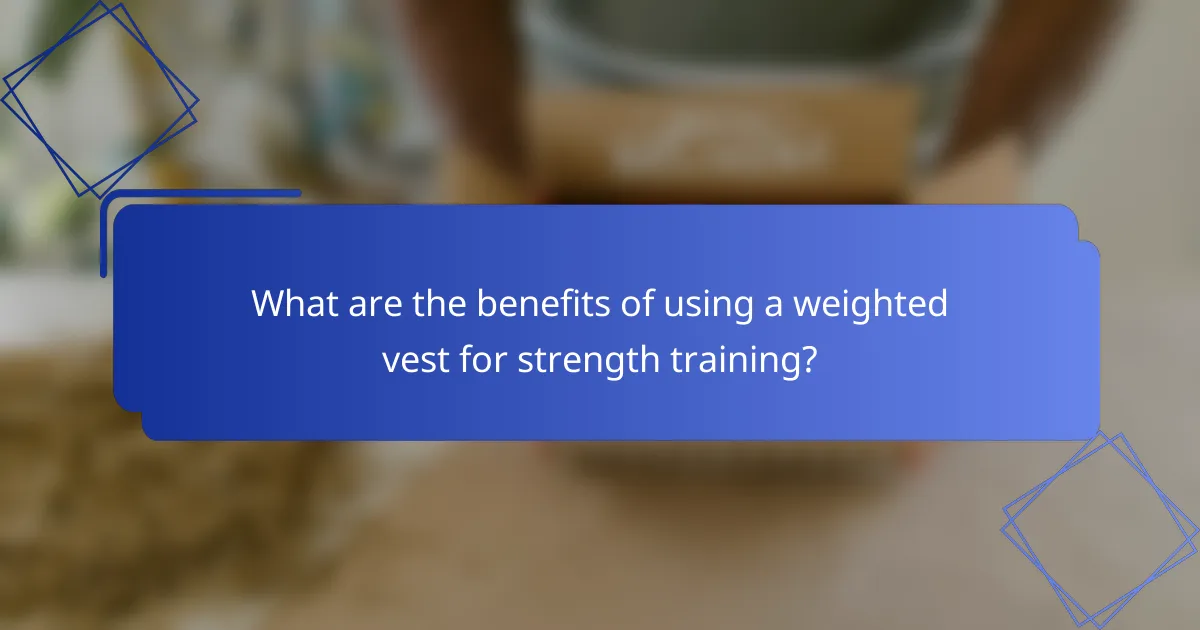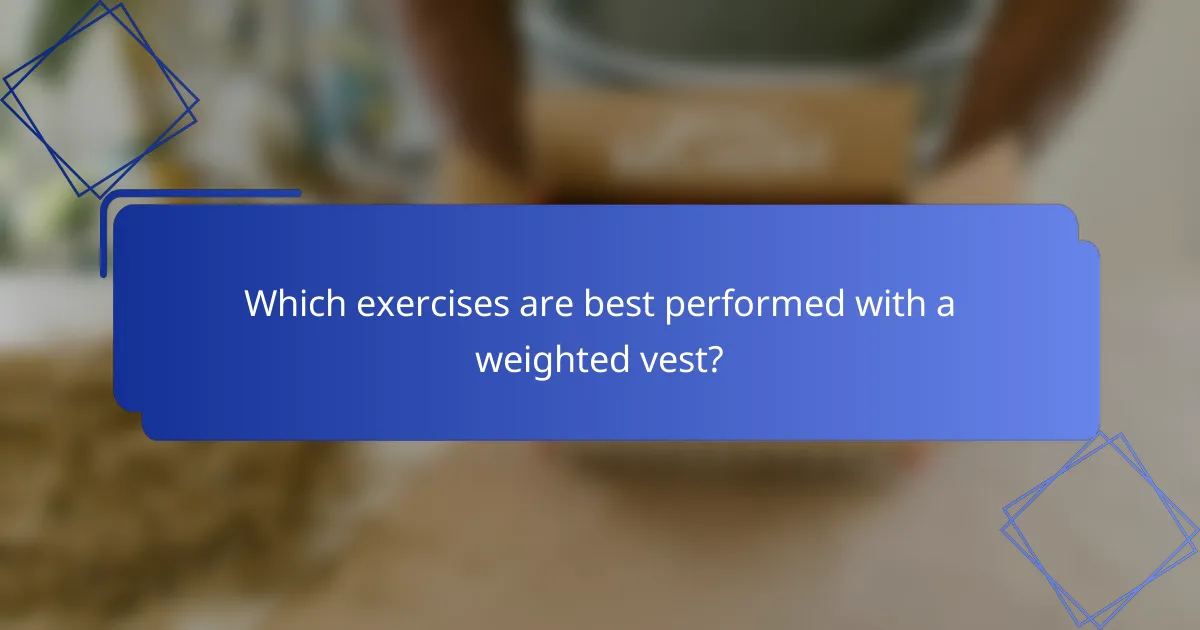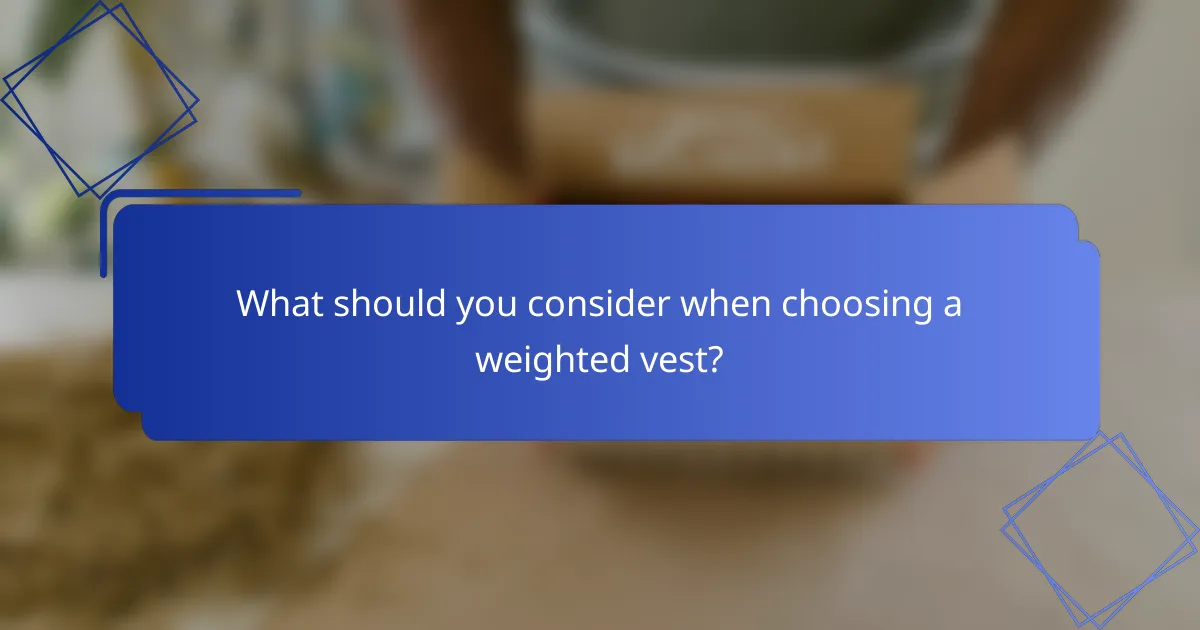A weighted vest is an effective tool for increasing workout intensity by adding extra resistance to your exercises. This added weight not only challenges your muscles but also enhances your cardiovascular system, leading to improved strength and endurance. Incorporating a weighted vest into your training routine can significantly boost your functional fitness and overall performance.

How can a weighted vest increase workout intensity in Canada?
A weighted vest can significantly enhance workout intensity by adding extra resistance to various exercises. This additional weight challenges your muscles and cardiovascular system, leading to improved strength and endurance over time.
Enhanced resistance training
Using a weighted vest during resistance training increases the load on your muscles, promoting greater strength gains. For example, when performing squats or push-ups, the added weight forces your muscles to work harder, which can lead to improved muscle hypertrophy and strength development.
Start with a vest that adds around 5-10% of your body weight and gradually increase as your strength improves. Be cautious not to overload yourself, as this can lead to improper form and potential injury.
Improved cardiovascular performance
A weighted vest can elevate your heart rate during cardiovascular workouts, enhancing overall performance. Activities like running, walking, or cycling become more challenging, which can lead to better aerobic capacity and endurance.
Consider incorporating a weighted vest into your routine for interval training or hill workouts. Aim for sessions where the vest adds a manageable weight, ensuring you maintain proper form and avoid excessive fatigue.
Increased calorie burn
Wearing a weighted vest can significantly increase the number of calories burned during exercise. The added weight requires more energy expenditure, which can contribute to weight loss or improved body composition over time.
Research indicates that adding weight can boost calorie burn by approximately 10-20% during workouts. To maximize this effect, combine the vest with high-intensity interval training or longer-duration cardio sessions, while monitoring your body’s response to the increased load.

What are the benefits of using a weighted vest for strength training?
Using a weighted vest for strength training can significantly enhance workout intensity, leading to improved muscle strength and endurance. By adding extra weight, you challenge your body more than with bodyweight exercises alone, promoting greater gains in strength and functional fitness.
Boosted muscle growth
A weighted vest increases the load on your muscles during exercises, which can stimulate greater muscle hypertrophy. This added resistance forces your muscles to adapt and grow stronger over time. For optimal results, consider using a vest that adds 10-20% of your body weight, adjusting as your strength improves.
Incorporate exercises like push-ups, squats, and pull-ups with the vest to maximize muscle engagement. Gradually increase the weight as you progress to continue challenging your muscles.
Improved endurance
Wearing a weighted vest during cardio workouts can enhance your endurance by forcing your cardiovascular system to work harder. This increased effort can lead to improved stamina over time, allowing you to perform longer and more intense workouts.
For effective endurance training, try wearing the vest during activities like running, hiking, or cycling. Start with lighter weights and gradually increase as your endurance builds, aiming for a weight that feels challenging but manageable.
Enhanced functional strength
Weighted vests help develop functional strength, which is the ability to perform everyday activities more efficiently. By mimicking the weight of carrying groceries or lifting objects, these vests prepare your body for real-life movements.
Incorporate functional exercises such as lunges, step-ups, and kettlebell swings while wearing the vest. Focus on maintaining proper form to prevent injury and maximize the benefits of your training.

Which exercises are best performed with a weighted vest?
Weighted vests can enhance various exercises by adding resistance, which increases workout intensity and improves strength. They are particularly effective for bodyweight exercises, cardio workouts, and strength training routines.
Bodyweight exercises
Bodyweight exercises, such as push-ups, pull-ups, and squats, benefit greatly from the added resistance of a weighted vest. This extra weight forces your muscles to work harder, leading to improved strength and endurance over time.
When incorporating a weighted vest into bodyweight exercises, start with a light weight, around 5-10% of your body weight, to avoid compromising form. Gradually increase the weight as you become more comfortable and stronger.
Cardio workouts
Weighted vests can significantly enhance cardio workouts, including running, walking, and jumping rope. By adding weight, you increase the intensity of your workout, which can lead to greater calorie burn and improved cardiovascular fitness.
For cardio exercises, consider using a vest that allows for easy adjustments in weight. A range of 5-20 pounds is generally effective, depending on your fitness level and the specific activity. Monitor your heart rate to ensure you stay within a safe range.
Strength training routines
In strength training, weighted vests can complement exercises like deadlifts, bench presses, and lunges. They provide additional resistance without the need for free weights, making them a versatile option for various training environments.
When using a weighted vest for strength training, ensure it fits snugly to prevent shifting during movements. Start with a modest weight and focus on maintaining proper form to avoid injury. Aim for a vest weight that allows you to perform 8-12 repetitions comfortably.

What should you consider when choosing a weighted vest?
When selecting a weighted vest, consider factors such as weight distribution, fit and comfort, and material quality. These elements significantly impact your workout experience and effectiveness.
Weight distribution
Weight distribution in a weighted vest affects balance and movement during exercises. Ideally, the weight should be evenly spread across the vest to prevent strain and ensure stability. Look for vests that allow you to adjust the weight, typically ranging from 5 to 50 pounds, to suit your fitness level and training goals.
Uneven weight can lead to discomfort or injury, especially during high-intensity workouts. Test the vest by moving around to ensure it feels secure and balanced on your body.
Fit and comfort
Fit and comfort are crucial when choosing a weighted vest, as a poor fit can hinder performance and lead to chafing. The vest should be snug but not restrictive, allowing for a full range of motion. Adjustable straps or sizes can help achieve a better fit.
Consider the length of the vest as well; it should cover your torso without being too long or short. A well-fitted vest will enhance your workout experience, making it easier to focus on your training rather than discomfort.
Material quality
Material quality impacts the durability and breathability of a weighted vest. Look for vests made from high-quality, breathable fabrics that can withstand rigorous use. Common materials include nylon and neoprene, which offer durability and comfort.
Additionally, check for features like moisture-wicking properties and reinforced stitching. Investing in a well-constructed vest can save you money in the long run, as it will last through many workouts without losing shape or functionality.

How do weighted vests compare to other training tools?
Weighted vests are versatile training tools that enhance workout intensity and improve strength by adding extra weight to the body during various exercises. Compared to ankle weights and resistance bands, weighted vests provide a more balanced distribution of weight, allowing for functional training that mimics real-life movements.
Versus ankle weights
Weighted vests differ from ankle weights primarily in their weight distribution and versatility. While ankle weights are typically strapped to the lower legs, which can alter gait and lead to joint strain, weighted vests distribute weight evenly across the torso, promoting better posture and stability during workouts.
Using a weighted vest allows for a wider range of exercises, including upper body movements, without the risk of compromising form. For example, performing push-ups or squats with a vest can enhance muscle engagement more effectively than ankle weights.
Versus resistance bands
Resistance bands provide variable resistance throughout an exercise’s range of motion, while weighted vests offer constant weight. This difference means that resistance bands can be more suitable for strength training focused on muscle contraction, whereas weighted vests are ideal for functional training that emphasizes endurance and overall strength.
Incorporating a weighted vest during bodyweight exercises like pull-ups or lunges can significantly increase intensity and challenge muscle groups more than resistance bands alone. However, combining both tools can yield comprehensive benefits, as each serves distinct training purposes.
